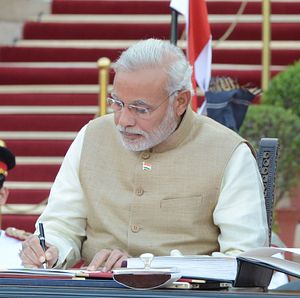The media is supposed to be the fourth pillar of democracy and act as the collective consciousness of a country. Questioning the establishment is part of its raison d’être. Becoming close to a ruling party undermines this mission. A section of Indian media seems to have forgotten its moral responsibility and has become a conformist ally of the government.
This was very much evident last week when Prime Minister Narendra Modi invited journalists to his party office in New Delhi. A large number of Delhi-based media personalities descended on the Bharatiya Janata Party (BJP) office. Some went with the hope that that the prime minister, breaking the norm, would hold an open press conference. No such luck. The popularly elected Modi, who received a historic majority in the 2014 general elections, has not held a single press conference in India during his last eighteen months in power. The meeting last week was no exception.
However, something newsworthy did emerge from the event: the whole affair turned into a spectacle when some journalists used the opportunity to take selfies with Modi. Many Indian journalists seem to have forgotten their crucial responsibility towards the Indian people. The scramble for selfies with Modi has drawn ridicule from commentators from both within the fraternity and outside.
Omar Abdullah, former chief minister of Jammu and Kashmir, tweeted the following: “Is this the media we expect will ask tough questions of this government? Great visuals of an undignified selfie circus!!!”
A Kolkata-based English newspaper, the Telegraph, made Abdullah’s tweet its front page cover on Sunday. The newspaper questioned the credentials of these journalists who apparently failed to maintain the necessary critical distance from the government.
The newspaper’s senior journalist, Kuldip Nayar, writes that “Modi is a master of public relations. He does not deserve all this adulation because he has not delivered anything on the ground. Today’s journalists lack guts. The establishment does not have to do anything because journalists willingly offer their necks.”
Ever since the new regime in Delhi assumed power in May 2014, it has kept journalists at a distance. It has even gone to the extent of denying them entry into some of the government offices and barring any interactions with officials. The powerful Prime Minister’s Office (PMO), which in past used to have a liaison officer to interact with the media, has been without any spokesperson since the BJP was elected.
Furthermore, Modi has disbanded the well-established practice of the prime minister taking journalists with him when he travels abroad. The government also does not allow journalists and other media persons to stay at the same hotel as the prime minister.
It is unprecedented in Indian history to have a prime minister treat the media with such disdain. Modi’s behavior is an open insult to the media, which has been denied its right to question the government’s policies and decisions. The Editors Guild of India has requested that the government engage with the media at regular intervals, but not much progress has been made.
However, this does not mean that Modi isn’t talkative. He is very active on social media, at conferences, and even addresses the people directly through the radio every month. He additionally holds rockstar-like events when he travels abroad. But the communication is one-sided. He does not often taken questions. Modi’s predecessor, Manmohan Singh, who was criticized for being a silent leader, addressed scores of open press conferences and interacted with the media regularly during his decade-long tenure.
In a scathing article titled “Selfie-Made Journalist” in the Indian Express, senior journalist Pamela Philipose asked: “When we surrender to the enchantment of getting intimate with power embodied in the persona of the PM, it raises eyebrows — and questions.” She further writes that “the fourth estate must necessarily firewall itself from the other three estates… in order to hold them to account for the sake of a vibrant, functioning democracy.”
The BJP government has been systematically silencing those who ask uncomfortable questions. The clampdown on civil society groups is a recent example. By ignoring the media, the government is trying to silence the fourth estate, which holds the establishment to account.
With so many crucial topics occupying Indian society today, the fact that the journalists present at the BJP headquarters failed to confront Modi underlines the sad state of affairs in the media in India today.

































